| Year | Name(s) | Image | Type | Notes |
|---|
| 1954 | Ali Baba |  | Pendulum ride | The Ali Baba is a type of amusement ride consisting of a stationary horizontal gondola with a 360 degree swinging pendulum. |
| 1961 | Alpine slide |  | | A summer toboggan is an amusement or recreational ride which uses a bobsled-like sled or cart to run down a track usually built on the side of a hill. There are two main types: an Alpine coaster or mountain coaster is a type of roller coaster where the sled runs on rails and is not able to leave the tracks, whereas with an Alpine slide the sled simply runs on a smooth concave track usually made of metal, concrete or fibreglass. Both of these types of ride are sometimes denoted with the German name Sommerrodelbahn. |
| 1948 | Balloon Race |  | | The Zamperla Balloon Race is a tilting, circular motion amusement park ride manufactured by Antonio Zamperla S.p.A. The ride makes its way up a structure, and at a certain height, it starts tilting. |
| 1965 | Bayern Kurve |  | | The Bayern Kurve is a roller coaster like amusement ride that moves a train around a banked circular track, gaining speed as the ride progresses. It is made in both a portable and park model and originally debuted in 1965. It was invented by German engineer Anton Schwarzkopf. |
| 1952 | Booster (Fabbri) |  | Pendulum ride | Booster in an amusement ride made by Fabbri. |
| 1998 | Booster (HUSS) |  | | The Booster is an amusement park ride made originally by HUSS Maschinenfabrik starting in 1998. |
| 1985 | Breakdance |  | | Breakdance is an amusement ride designed by Huss Maschinenfabrik GmbH & Co. KG in 1985. |
| 1972 | Bumper boats |  | Water ride | Bumper boats are an amusement park ride that uses inner tube shaped watercraft that can be steered by the rider. Some are driven by electric motors, some by gasoline engines, and some require the rider to propel the craft by pedaling. Most are equipped with water guns for duels with other riders. Bumper boat attractions can commonly be found in places such as amusement parks, carnivals, fairs, family fun centers, and theme parks. |
| 1939 | Bubble bounce | | | |
| 1920s | Bumper cars | 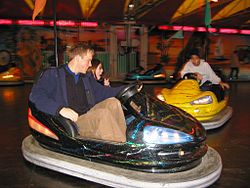 | Dodgems | Bumper cars or dodgems are the generic names for a type of flat amusement ride consisting of multiple small electrically powered cars which draw power from the floor or ceiling, and which are turned on and off remotely by an operator. They are also known as bumping cars, dodging cars and dashing cars. The first patent for them was filed in 1921. |
| Late 1600s | Carousel |  | Merry-Go-Round | A carousel is a type of amusement ride consisting of a rotating circular platform with seats for riders. The "seats" are traditionally in the form of rows of wooden horses or other animals mounted on posts, many of which are moved up and down by gears to simulate galloping, to the accompaniment of looped circus music. |
| 1922 | Caterpillar |  | | The Caterpillar ride is a vintage flat ride engineered by the inventor Hyla F. Maynes of North Tonawanda, New York, that seems to have been first operated by the Johnny Jones Exposition traveling show in 1922. [5] It generates a significant amount of centrifugal force, causing the riders on the inside of the seats to crush the riders on the outside of the seats. It was once found at nearly every amusement park around the United States, but is now very rare. |
| 1996 | Chaos |  | | |
| 1954 | Cliffhanger |  | | The Cliff Hanger is an amusement park rider that is meant to simulate hang gliding. |
| 1984 | Condor | 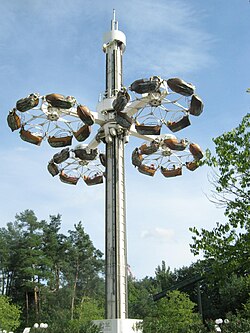 | | The Condor is the trade name of an amusement ride sold by HUSS of Bremen, Germany. It was debuted at the 1984 New Orleans World's Fair, under the name "Cyclo Tower". |
| 2003 | Disk'O | 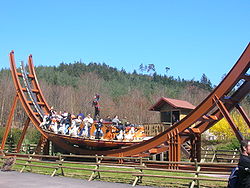 | | The Disk'O (also known as Skater or Surf's Up) is a type of flat ride manufactured by Zamperla of Italy. The ride is a larger version of a Rockin' Tug, also manufactured by Zamperla. |
| 1907 | Devil's wheel |  | | |
| 1943 | Double Shot | 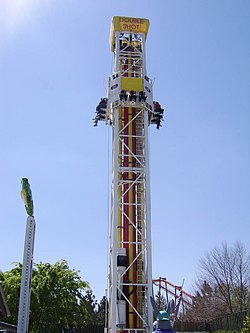 | Drop tower | a drop tower that drops riders down at high speeds |
| 1972 | Enterprise |  | | |
| 1992 | Evolution |  | pendulum ride | |
| 1980 | Explorer | | | |
| 1893 | Ferris wheel |  | | |
| 1972 | Fireball | 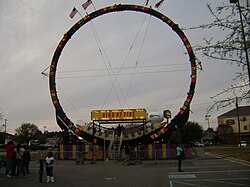 | | |
| 1989 | Flight Trainer | | | |
| 1959 | Flying Coaster |  | | |
| 1935 | Flying Scooters |  | | |
| 1948 | Fly-O-Plane |  | | |
| 1953 | Freak out |  | Pendulum ride | |
| 1982 | Freefall |  | Drop tower | riders freefall at a high speeds |
| 1994 | Frisbee |  | Pendulum ride | |
| 1954 | Fun Slide |  | | |
| 1983 | Gravitron |  | | |
| 1954 | Gyro tower |  | | |
| 1893 | Haunted swing |  | | A haunted swing is a vintage amusement ride that creates the illusion of apparent motion by independently rotating the room around a swinging platform. | | |
| Hayride |  | | |
| 1905 | Helter skelter |  | | |
| 1940s | Hurricane |  | | |
| 1960s | Infinity |  | Pendulum ride | |
| 1950s | Inversion |  | Pendulum ride | |
| 1950s | Jump and Smile |  | | |
| 1984 | Kamikaze |  | Pendulum ride | |
| 1930 | Kiddie ride |  | | A kiddie ride is a child-sized, themed, mildly interactive coin-operated ride that can be ridden by young children for amusement. |
| 1982 | Looping Starship |  | Pendulum ride | |
| 1952 | Loop Fighter | | Pendulum ride | |
| 1933 | Loop-O-Plane |  | | |
| 1933 | Loop-the-Loop [6] | 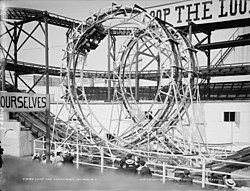 | | |
| 1929 | Madhouse |  | Dark ride |
| 1989 | Magic | | | |
| 1926 | Matterhorn |  | | |
| 1930s | Mechanical bull |  | | |
| 1982 [7] | Miami Trip ( wd ) |  | Thrill ride | |
| 1996 | Mixer | | | |
| 1977 | Monster |  | | |
| 1986 | Motion simulator |  | | |
| 1954 | Music Express | 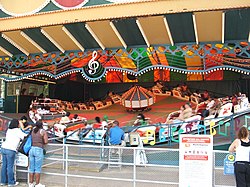 | | |
| 1952 | Octopus | 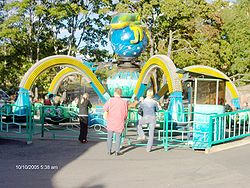 | | |
| 1895 | Old Mill |  | Water ride | |
| 1968 | Omnimover |  | | |
| 1976 | Orbiter |  | | |
| 1957 | Paratrooper |  | | |
| c.1893 | Pirate Ship |  | Pendulum ride | |
| 1999 | Power Surge |  | | |
| 1983 | Rainbow |  | | |
| 1981 | Ranger | 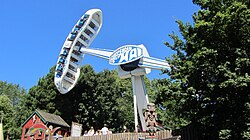 | Pendulum ride | |
| 1971 | Red Baron |  | | |
| c.1978 | Reverse bungee |  | | |
| 1956 | River caves |  | Water ride | |
| 1980 | River rapids ride |  | Water ride | |
| 1978 | Rockin' Tug |  | | |
| 1948 | Rock-O-Plane |  | | |
| 1974 | Rockstar | | Pendulum ride | |
| 1700s | Roller coaster |  | | The roller coaster is an amusement ride developed for amusement parks and modern theme parks. LaMarcus Adna Thompson obtained a patent regarding roller coasters on January 20, 1885, which were made out of wood, but this patent is considerably later than the "Russian mountains" described in the article. |
| 2013 | Rollglider | | | The Rollglider is a type of a thrill amusement ride that has a steel pipe track designed with turns, dips and loops, using gravity-propelled trolleys to slide down the track. |
| 1970s | Roll-O-Plane |  | | |
| 1940s | Rotor |  | | The Rotor is an amusement ride designed and patented by German engineer Ernst Hoffmeister in 1948. The ride was first demonstrated at Oktoberfest 1949 and still appears in numerous amusement parks. The Rotor is a large, upright barrel, rotated to create an inward acting centripetal force supplied by the wall's support force. Once at full speed, the floor is retraced, leaving the riders stuck to the wall of the drum. |
| 1990s | Rotoshake | | |
| 1940s | Round Up |  | | |
| 1938 | Scrambler |  | Flat ride | |
| 2004 | Screamin' Swing |  | Pendulum ride | |
| 1884 | Shoot the Chute |  | Water ride | |
| 2003 | Sky Swatter |  | | |
| 1992 | Skycoaster | 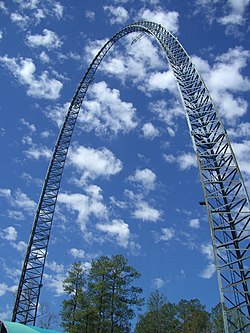 | | |
| 1965 | Skydiver |  | | |
| 2012 | Sky Fly | | Flat Ride | A ride that has an arm that spins carrying suspended riders. The riders can flip themself using the wings on each side of the seat. [8] |
| 1963 | Skywheel | | | The Skywheel is a ride that is essentially a double Ferris Wheel with each wheel attached on each end of a large boom that rotates on its axis causing the wheels to rise and fall while rotating independently as they rotate around the boom axis causing a gravitational thrill more spectacular than a normal Ferris Wheel. The ride was constructed by now defunct company Allan Herschell Company. [9] |
| 1891 | Somers' Roundabout |  | Flat Ride | A wooden precursor to the Ferris wheel. |
| 1996 | Space Shot |  | Drop tower | |
| 2000 | Speed |  | Pendulum ride | |
| 1940s | Star Flyer |  | Swing ride | |
| 1955 | Super Shot | | Drop tower | |
| 1996 | Super Star |  | | |
| 1960 | Swing Around |  | | |
| 1830s | Swing boat |  | Pendulum ride | |
| 1951 | Tagada |  | | |
| 1948 | Teacups |  | | |
| 1914 | The Whip |  | | |
| 1926 | Tilt-A-Whirl |  | | |
| 1996 | Top Scan |  | | |
| 1990 | Top Spin |  | | |
| 2002 | Topple Tower |  | Pendulum ride | |
| 1955 | Tornado (Mondial) | 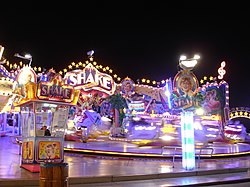 | | |
| 1951 | Tornado (Wisdom) |  | | |
| 1944 | Tow boat ride |  | Water ride | |
| Late 1800s | Train ride | 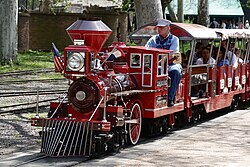 | | |
| 1977 | Tri-Star | | | |
| 1970s | Troika |  | | |
| 1930s | Tumble Bug |  | | |
| 1970 | Turbo | | | |
| 1950s | Turbo Drop |  | Drop tower | |
| 1953 | Twist |  | | |
| 1978 | UFO |  | | |
| 1957 | UltraMax |  | | |
| 1933 | Waltzer | 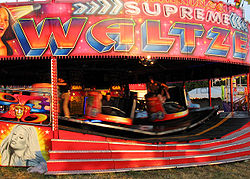 | | |
| 1963 | Wipeout | 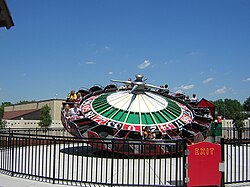 | | |
| 1907 | Witching Waves |  | | Witching Waves is a historical flat ride that propels light cars using waves created in its flexible metal oval track by levers underneath that rise and fall in sequence. | | |
| 1968 | Zipper |  | | |






































































































